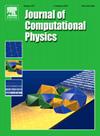通过 DR-PDEE 对受乘法噪声影响的高维非线性系统进行高效随机响应分析
IF 3.8
2区 物理与天体物理
Q2 COMPUTER SCIENCE, INTERDISCIPLINARY APPLICATIONS
引用次数: 0
摘要
对于受乘性白噪声影响的高维非线性动力系统的可靠概率分析,特别是在概率密度水平上,仍然存在重大挑战。为了解决这一问题,提出了一种有效的方法,即采用降维概率密度演化方程(DR-PDEE)来确定此类系统中响应的概率密度。该方法的出发点是,在许多情况下,系统中只有有限数量的量是感兴趣的。因此,相应的DR-PDEE是一个一维或二维偏微分方程(PDE),它控制高维随机动力系统中感兴趣的数量/响应的瞬时概率密度函数(PDF)。这是在响应满足路径连续性条件的前提下,并且对激励是乘性的或加性的没有限制。DR-PDEE中的固有漂移和扩散函数是原始高维系统的这些响应的条件期望函数,可以可靠地估计,其中评估后者是特定于乘性噪声问题的。有趣的是,对于一大类受倍增性局部噪声影响的系统,其本征扩散函数是解析可确定的。然后,通过对一维或二维DR-PDEE进行数值积分,可以有效地获得感兴趣量的瞬时PDF。通过几个典型的高维非线性动力系统,验证了DR-PDEE的精度和效率。特别是,DR-PDEE准确地捕获了容易被忽视的精细特征,以及响应pdf的尾部范围。本文章由计算机程序翻译,如有差异,请以英文原文为准。
Efficient stochastic response analysis of high-dimensional nonlinear systems subject to multiplicative noise via the DR-PDEE
Significant challenges persist for the reliable probabilistic analyses of high-dimensional nonlinear dynamical systems subject to multiplicative white noise, particularly at the level of probability density. To address this issue, an efficient method is proposed by employing the dimension-reduced probability density evolution equation (DR-PDEE) to determine the probability density of the responses in such systems. The starting point of the method is that, in many cases, only a limited number of quantities in a system are of interest. Thus, the corresponding DR-PDEE is a one- or two-dimensional partial differential equation (PDE) that governs the instantaneous probability density function (PDF) of the quantity/response(s) of interest in high-dimensional stochastic dynamical systems. This is with the stipulation that the response meets the path continuity condition, and there is no restriction on the excitations being multiplicative or additive. The intrinsic drift and diffusion functions in the DR-PDEE are conditional expectation functions of these responses of the original high-dimensional systems that can be reliably estimated, where assessing the latter is specific to multiplicative noise problems. Interestingly, for a wide class of systems subject to multiplicative local noise, the intrinsic diffusion functions are analytically determinable. Subsequently, the instantaneous PDF of the quantity of interest can be efficiently obtained by numerically integrating the one- or two-dimensional DR-PDEE. The accuracy and efficiency of the DR-PDEE are verified by several typical nonlinear high-dimensional dynamical systems. Particularly, the DR-PDEE captures accurately the refined traits that are easily overlooked, and the tail range of response PDFs.
求助全文
通过发布文献求助,成功后即可免费获取论文全文。
去求助
来源期刊

Journal of Computational Physics
物理-计算机:跨学科应用
CiteScore
7.60
自引率
14.60%
发文量
763
审稿时长
5.8 months
期刊介绍:
Journal of Computational Physics thoroughly treats the computational aspects of physical problems, presenting techniques for the numerical solution of mathematical equations arising in all areas of physics. The journal seeks to emphasize methods that cross disciplinary boundaries.
The Journal of Computational Physics also publishes short notes of 4 pages or less (including figures, tables, and references but excluding title pages). Letters to the Editor commenting on articles already published in this Journal will also be considered. Neither notes nor letters should have an abstract.
 求助内容:
求助内容: 应助结果提醒方式:
应助结果提醒方式:


